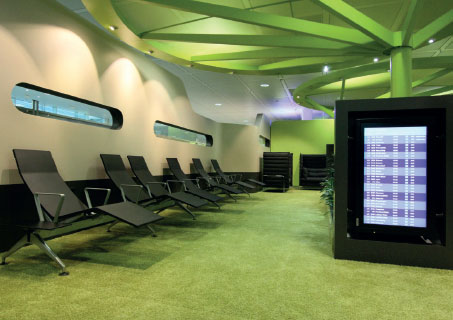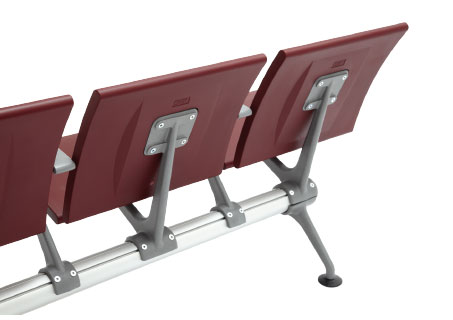
Vitra’s Work Relax and Sleep area at Munich Airport’s Terminal 2 enables both privacy or social interaction, while its beam-seating products have widely variable dimensions so they can be adapted to fit available space.
In furnishing airports, seating designers need to create a product with a high functional and aesthetic life expectancy that fulfills the conflicting interests of both passenger and airport. “We have on one side the airport, which is looking for a durable, low-maintenance and very sturdy solution, whereas passengers just want somewhere comfortable to sit down,” explained Pascal Berberat, Head of Airport Division, Vitra International. Vitra brings together enterprising Swiss engineering with international design ingenuity to create public seats for airports the world over. “We understand that an airport is a machine built for efficiency,” he said. “But the passenger should not be bothered by what is going on behind the scenes.” Vitra supports airports by providing products and services that facilitate airport processes invisibly in the background while meeting the needs of passengers, like the public Work Relax and Sleep zone in Munich Airport’s Terminal 2. Intelligently designed sofas, reclining loungers, worktables enable both privacy and productivity. “There is a match,” Berberat asserted. “An airport is a very diverse area, like a city, offering a variety of services, and with our very diverse product portfolio, we can find the answer for every different area.”

OMK Design’s Trax Hub seat features inbuilt USB ports and plugs to meet one of the most common needs of passengers – a place to charge their phones and run their laptops.
Seating solutions for the future
As airport environments continue to evolve, the requirement for seating to cater for multiple passenger profiles is now more important than ever. In this regard London-based furniture manufacturer OMK Design is in constant consultation with the industry’s foremost architects and operators to ensure that its products are truly future-proof.
Providing the right type of seating for each area is key to satisfying the needs of every passenger. Business travellers, for example, now require many of the facilities traditionally provided in airline lounges within the main terminal. This has led operators to move away from conventional linear units, which do not offer dynamic layouts, in favour of group seating such as OMK’s Trax Hub. This can be used singularly, offering added privacy and optional power integration provides a comfortable place to work.
It is equally important to provide a sufficient number of seats for passengers waiting at the boarding gates – a developing problem with the ever-increasing capacity of new generation aircraft. Unlike new-build projects, which are designed to hold larger numbers of passengers at the gates, evolving airports face the problem of fitting in more seats to their existing footprint. Identifying this need, OMK has developed a new system, the T500, with a small footprint giving a greater seating density.







